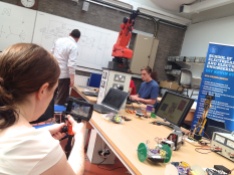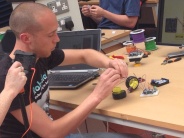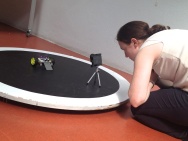
RTE’s Sinead Morris filming DIT’s Ted Burke using a kitted-out iPhone 5.
TV journalist Sinead Morris came to DIT’s Kevin Street location today to film robot construction in action. Our RoboSlam team leaders — Ted, Damon, Frank, and I — are preparing for the upcoming Dublin Maker event, to be held at Trinity College on Saturday, July 26. Sinead wanted to capture the activity.
The Dublin Maker event served as the impetus, Sinead explained, but the main intention of her piece is to show what the RoboSlam group is doing with robotics.
Sinead’s production is likely to air on RTE’s digital news channel, News Now.

Ted and Sinead set up for a shot of the robot underworld.
Sinead is testing photojournalism innovations. The Irish television company where she works, RTE, wants its journalists to gain experience with spontaneous, low-tech approaches — so staff members can shoot, edit, and post “on the go.” At the end of this innovation project, RTE staff will have the skills needed to disseminate news on the run… when opportunities arise.
RTE asked its staff to take this challenge: produce interesting and informative pieces wholly on their iPhones.
Hampton University journalism students were learning to do the same when my friend Tony Brown was dean of the program so, for me, watching this process firsthand proved fascinating. The move toward spontaneous creation of new content aligns with the goals for our RoboSlam project; we want our workshop participants to take their robots home and start creating new “home grown” code for operating the ‘bots.
TV news technology has come a long way in my lifetime. When I was a kid in the ’70s and ’80s, my parents were television journalists. They used 16mm film equipment, and I learned to use the same when I was in college studying architecture.
Today’s capture-edit-and-post culture speeds the process. Mom and Dad used to shoot the footage and put it on a Trailways bus bound for the TV station one hour away. While it was in transit, they’d phone the station to make a voice recording of the text for the station to overlay.
It would appear in its synchronized form on that night’s news.
Now, Viola!, Sinead can do, alone and in moments, what it took dozens of people hours to create in the 1980s.

Robot show down.
So, I was able to learn quite a bit from Sinead today, about software as well as hardware, and perhaps now I can give her videography techniques a go.
She also inspired me to write up this blog on site, while she’s finishing up her interview with Ted. Moments ago, she asked him what it’s like to work this type of job. He said he loves coming in every day to build robots and work with students.
He didn’t mention that he and his colleagues are currently on vacation and aren’t at all required to be here. They just can’t keep themselves away!
We actually had quite a few interesting projects underway in the lab today while we were filming… a veritable Santa’s workshop of robotics. For instance, one of DIT’s third year students, Shane Ormonde, was here developing a new robot to show at the Dublin Maker event. He just completed a degree in Electrical and Control Engineering (DT009) and will pursue yet another degree in the fall.
Shane is conducting a robotics experiment while on summer holiday. It’s a nice break, he says, from his call-center job. (Gotta love that initiative!)

Shane Ormonde’s new global robot arm.
Shane is building and programming a robotic system that, using a globe, can show in real time what the International Space Station is actually tracking at the same moment. Eventually, his robot will also be able to point to any location a person requests, using the laser on the end of its moving arm.
The globe itself moves to set the correct longitude and the arm moves to pinpoint the latitude.
He originally wanted people to be able to tune in via internet to ask the robot to identify specific locations and complete other such actions. Shane’s creation will be featured as one part of our DIT RoboSlam exhibit at the Dublin Maker event.
Come join us next Saturday – near the cricket pitch at Trinity – and see!

Shane Ormonde’s new global robot arm.

RTE’s Sinead Morris filming DIT’s Ted Burke using a kitted-out iPhone 5.

RTE’s Sinead Morris filming DIT’s Ted Burke using a kitted-out iPhone 5.

Robot show down.

Ted and Sinead set up for a shot of the robot underworld.































































